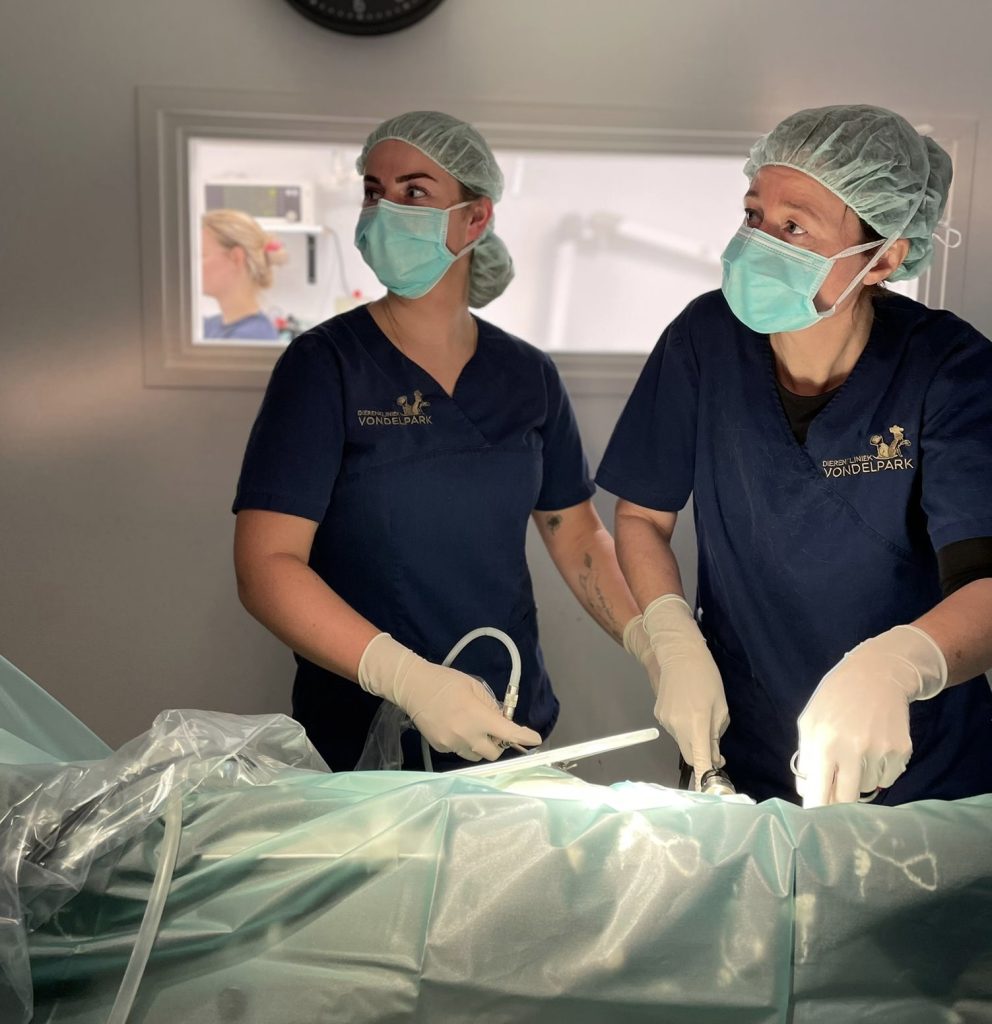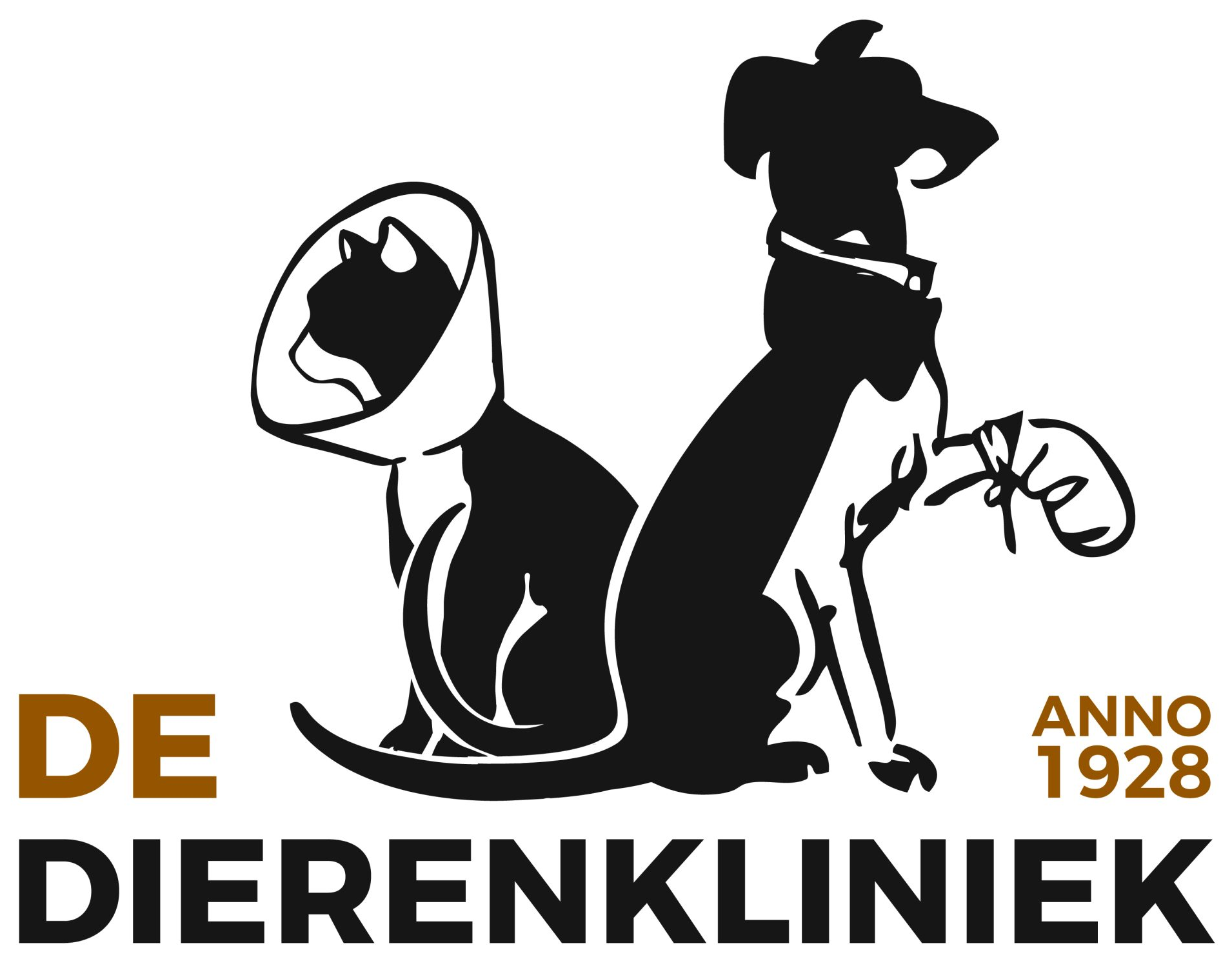Laparoscopic spay in dogs
At De Dierenkliniek, we can perform a laparoscopic spay on your dog. This “keyhole” surgery is a minimally invasive procedure, which means less risk and a quicker recovery. Find out more about what a laparoscopic procedure involves for your dog.
What is a laparoscopic spay in dogs?
Spaying a dog involves surgically removing the reproductive organs. In a laparoscopic spay, the abdomen is inflated with gas, and the surgeon makes one or two very small incisions in the abdominal wall. Through these tiny openings, a camera and surgical instruments are inserted to access the abdominal cavity. The camera’s image is displayed on a screen, allowing the surgeon to see clearly. Both ovaries are carefully detached inside the abdomen and then removed through the same small openings.
How is a laparoscopic spay different from a traditional spay?
In a traditional spay, the surgeon makes an incision in the dog’s abdomen to reach the ovaries. In female dogs, the ovaries are located deep in the abdominal cavity near the back. The larger the dog, the deeper the surgeon must reach. The blood vessels are tied off, the ovaries are removed, and the abdominal wall is then stitched closed.
In a laparoscopic spay, the surgeon makes one or two much smaller incisions (about 5–10 mm) in the abdomen. Carbon dioxide gas is used to gently inflate the abdominal cavity, creating space and providing a clear view. Through these small openings, the surgeon inserts a camera and specialized instruments. The camera’s image is magnified on a screen, allowing precise work. The blood vessels to the ovaries are sealed, and the ovaries are removed through the same tiny incisions.
What is the best way to spay a dog: traditional or laparoscopic?

Research shows that larger dogs spayed using the traditional method move 62% less than normal the day after surgery. Dogs spayed laparoscopically, on the other hand, move only 25% less the day after surgery. This suggests that the laparoscopic method is likely less painful. Additionally, the smaller incision results in faster recovery and a lower risk of infection.
For smaller dogs, the surgeon doesn’t need to reach as deep into the abdomen to access the ovaries, and the incision in the abdominal wall is already smaller than in larger dogs. The laparoscopic technique is therefore especially suitable for dogs weighing around 10 kg or more. For dogs under 10 kg, the benefits are minimal, but the procedure is still possible.
What are the benefits of a laparoscopic spay for your dog?
The benefits of a laparoscopic spay include:
- The surgeon only makes one or two very small incisions in the abdominal wall. Smaller wounds mean your dog recovers faster.
- The risk of infection is minimized because the incisions are so small.
- In a traditional spay, the most sensitive part for the dog is sometimes manipulating the ovaries to access them. In a laparoscopic spay, this is hardly necessary because the instruments can reach the back of the abdomen more easily, resulting in less postoperative pain.
- Especially in larger dogs, the surgery—and therefore the anesthesia—can be shorter.
What are the disadvantages of a laparoscopic spay for your dog?
The disadvantages of a laparoscopic spay include:
- Laparoscopic spays require expensive equipment, and the veterinarian needs special training to perform the procedure. Additional assistance is also needed during surgery, which makes the procedure more costly than a traditional spay.
- If there are abnormalities in the uterus, the veterinarian may recommend removing it as well. Sometimes this is not possible through the small incisions, and a larger incision may be necessary.
- The dog’s abdomen is inflated with carbon dioxide during the procedure to create space. In some cases, this may cause mild abdominal discomfort afterward.
How does a laparoscopic spay work?
All of our clinics feature modern, fully equipped operating rooms, and our veterinarians have extensive surgical experience. Your dog is in safe, capable hands.
Before the procedure
It is important that your dog is fasting before the surgery. This means she should not eat for 8 hours prior to the procedure. Animals can vomit under anesthesia, and if they have eaten, food can get stuck in the throat. However, your dog may still drink water. For very small dogs, fasting for 4 hours before surgery is sufficient.
Take your dog for a walk before bringing her to the clinic. During anesthesia, dogs may urinate or defecate, which can get on their fur and affect hygiene during the procedure. It is also more comfortable for your dog to wake up with a clean coat and an empty bladder.
The procedure
Before your dog is put under anesthesia, we perform a thorough examination to ensure she is healthy. Next, an intravenous (IV) catheter is placed in a vein in the front leg. Through this IV, anesthetic drugs are administered, allowing your dog to fall asleep quickly and safely. A tube is then placed in the trachea to provide oxygen and inhalation anesthesia, and your dog is connected to monitoring equipment. During anesthesia, this equipment tracks your dog’s heart rate, ECG, and breathing. Additional IV fluids are given to maintain blood pressure.
During the surgery, both ovaries are removed. The uterus does not need to be removed, but we always inspect it for any abnormalities. After the ovaries are removed, the small incisions in the abdominal wall are closed with subcutaneous stitches.
Recovery and post-operative care
Your dog can go home on the same day as the surgery. Our assistant will call you to let you know what time you can pick up your dog. You will receive a detailed instruction sheet explaining exactly what to do after the procedure. Keep in mind that your dog has been under anesthesia and may still be groggy or get cold more easily. Walking long distances is therefore not recommended.
Drinking
Offer your dog small amounts of water after the surgery. Do not give too much at once, as drinking a lot quickly can cause vomiting.
Eating
A few hours after surgery, you may offer your dog some food. Start with about ¼ of the normal portion, as your dog may still feel a little nauseous from the anesthesia. We will provide a can of easily digestible food for the first evening.
Medication
Your dog will receive pain-relieving injections during the surgery. Occasionally, some dogs (especially Retrievers) may be a little whiny or restless due to these medications. This will pass on its own.
You will also receive pain medication for the first few days after surgery. You can start giving this the day after surgery. Even if you feel your dog is no longer in pain, it is important to continue, as these medications also help reduce inflammation. Antibiotics are not necessary.
The wound
The sutures are placed both in the skin and in the deeper tissue layers. If your dog jumps or makes sudden movements shortly after surgery, these sutures could tear. It is therefore important to keep your dog as calm as possible until the wound check (7–10 days). She should not touch or lick the wound. If she does, use a collar or a medical pet shirt. We recommend keeping these on until the wound check. Dogs should be kept on a leash when outside until the wound has been examined, and swimming is not allowed until then.
Wound check
Please bring your dog back to the clinic 7–10 days after surgery for a wound check. There is no charge for this visit. If the wound looks good, your dog can return to normal activities. Of course, you can always contact us in the meantime if you have any questions.
What are the costs of a laparoscopic spay?
The cost of a laparoscopic spay depends on your dog’s weight. For detailed pricing, please check our rates. You can also easily get a personalized estimate by contacting our clinics via phone, WhatsApp, or email—we’re happy to help!

